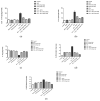Nano Methotrexate versus Methotrexate in Targeting Rheumatoid Arthritis
- PMID: 36678557
- PMCID: PMC9866098
- DOI: 10.3390/ph16010060
Nano Methotrexate versus Methotrexate in Targeting Rheumatoid Arthritis
Abstract
Nanomedicine has emerged as an important approach for targeting RA medication. Rheumatoid arthritis (RA) is a widespread autoimmune disorder marked by multiple inflamed joints. Gold nanoparticles (GNPs) have been demonstrated as efficacious nanocarriers due to their unique characteristics and the relative simplicity of their synthesis in varied sizes; moreover, they have the capability to alleviate several inflammatory markers. The current objective was to combine methotrexate (MTX) with GNPs to overcome MTX restrictions. GNPs were fabricated by a chemical reduction technique, utilizing sodium citrate and tween 20. The MTX-GNPs formulations were characterized in vitro by % entrapment efficiency (%EE), particle size, polydispersity index (PDI) zeta potential, and % release. The MTX-GNPs formulation was administrated as an intra-articular solution, and additionally, incorporated into a Carbopol gel to investigate its anti-arthritic effectiveness and bioavailability in vivo. The results indicated that a %EE of 87.53 ± 1.10%, and a particle size of 60.62 ± 2.41 nm with a PDI of 0.31 ± 0.03, and a zeta potential of −27.80 ± 0.36 mV were optimal. The in vitro release of MTX from the MTX-GNPs formulation demonstrated that the MTX-GNPs formulation’s release was 34.91 ± 1.96% and considerably (p < 0.05) lower than that of free MTX, showing a significant difference in dissolution patterns (p < 0.05). In vivo, MTX-GNPs formulations inhibited IL-6 by 36.52%, ACCP (63.25 %), COMP (28.16%), and RANKL (63.67%), as well as elevated IL-10 by 190.18%. Transdermal MTX-GNPs decreased IL-6 by 22.52%, ACCP (56.63%), COMP (52.64%), and RANKL (79.5%), as well as increased IL-10 by 168.37%. Histological investigation supported these recent findings. Conclusions: Marked improvements in MTX anti-arthritic effects are seen when it is conjugated to GNPs.
Keywords: bioavailability; effectiveness; gold nanoparticles; inflamed joints; intra-articular; nanomedicine; transdermal.
Conflict of interest statement
The authors declare no conflict of interest.
Figures





References
-
- Sadarani B., Majumdar A., Paradkar S., Mathur A., Sachdev S., Mohanty B., Chaudhari P. Enhanced skin permeation of Methotrexate from penetration enhancer containing vesicles: In vitro optimization and in vivo evaluation. Biomed. Pharmacother. 2019;114:108770. doi: 10.1016/j.biopha.2019.108770. - DOI - PubMed
-
- Ruaro B., Casabella A., Paolino S., Pizzorni C., Ghio M., Seriolo C., Molfetta L., Odetti P., Smith V., Cutolo M. Dickkopf-1 (Dkk-1) serum levels in systemic sclerosis and rheumatoid arthritis patients: Correlation with the Trabecular Bone Score (TBS) Clin. Rheumatol. 2018;37:3057–3062. doi: 10.1007/s10067-018-4322-9. - DOI - PubMed
-
- Guajardo-Jauregui N., Galarza-Delgado D.Á., Azpiri-López J.R., Colunga-Pedraza I.J., Cárdenas A., Garza-Cisneros A.N., Garcia-Heredia A., Balderas-Palacios M.A., Rodriguez-Romero A.B. POS0577 Comparison of the Who and Acc/Aha Cardiovascular Algorithms to Detect Carotid Plaque in Rheumatoid Arthritis. BMJ Ann. Rheum. Dis. 2022;81:555. doi: 10.1136/annrheumdis-2022-eular.5054. - DOI
-
- Joshi D.C., Naskar A., Datta K., Sarkar U., Otia M.K., Khatoon T. Rheumatoid Arthrities: Etiology Pathophysiology and Modern Treatments. Int. J. Res. Appl. Sci. Biotechnol. 2022;9:32–39. doi: 10.31033/ijrasb.9.3.7. - DOI
LinkOut - more resources
Full Text Sources
Miscellaneous

